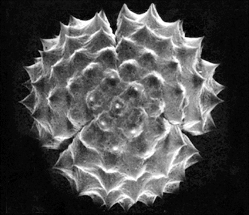Click on the name of a different pollen below to find out more about
it,
or click on the other microscope for a different view of this pollen.
| Plant: | Pollen: | Microscope: |
 |
 |
|
|
Cocklebur Like many wind-pollinated plants, cockleburs have tiny flowers that release enormous amounts of pollen into the air. Cockleburs are related to ragweed, and they are a troublesome hay fever plant. You're more likely to recognize cockleburs by their prickles than by their pollen. If you've ever stepped in a cocklebur patch you've probably come out with a busload of burs on your socks and shoes. These prickly plants grow thick in the rich soil of fields and riverbeds. The burs are actually a casing to protect the plant's seeds. The sharp hooks help the burs hitch a ride to new places where the seeds can put down roots. That's how the plant has traveled across oceans and continents. Cockleburs now grow all over the world. |